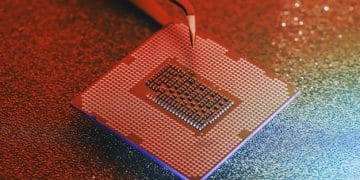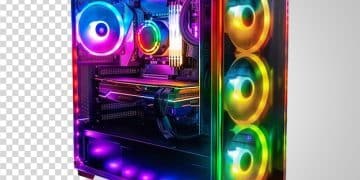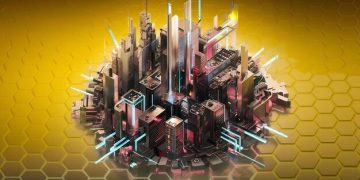How to Build a Silent PC for Under $1000 in 2025: A Comprehensive Guide
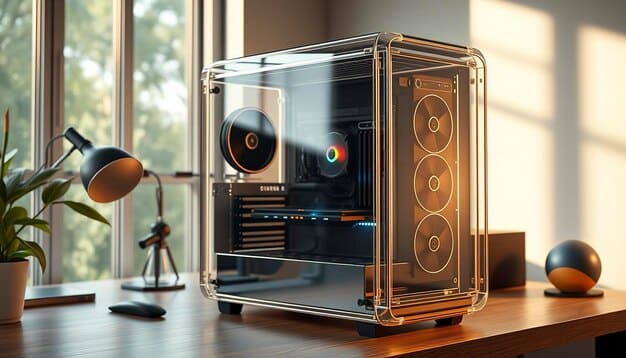
Building a silent PC for under $1000 in 2025 involves selecting components that minimize noise, such as a fanless CPU cooler, a quiet power supply, and a solid-state drive, while optimizing airflow and considering sound dampening cases.
Dreaming of a whisper-quiet computing experience without breaking the bank? Building a silent PC for under $1000 in 2025 is achievable with the right components and a bit of planning. Let’s explore how you can create a serene and powerful PC setup.
Choosing the Right Components for a Silent PC
Selecting the right components is crucial when aiming for a silent PC. Each part contributes to the overall noise level, so thoughtful choices can make a significant difference. This includes everything from the case to the storage.
CPU Cooler
The CPU cooler is often a major noise source. Consider a high-quality air cooler with a large, slow-spinning fan or, for even better silence, a passive (fanless) cooler.
Case Fans
Replace stock case fans with quieter models. Look for fans with fluid dynamic bearings (FDB) or rifle bearings, which are generally quieter than sleeve bearing fans.
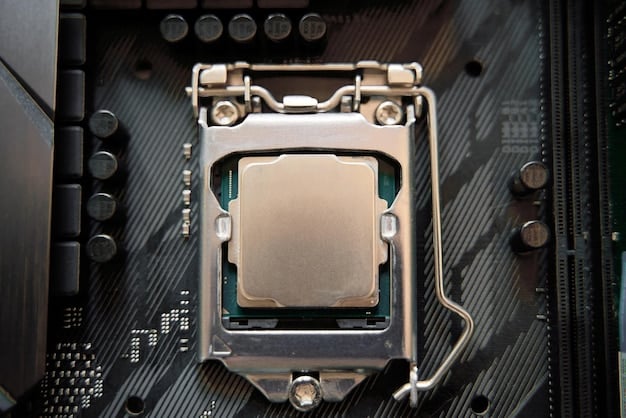
To summarize, quieter air cooling is the best option, and water cooling is also worth considering because of its low maintenace. Let’s dive into a list of the best components you must consider:
- Noctua NH-D15: Reputable brand/model, excellent cooling performance with low noise.
- be quiet! Dark Rock Pro 4: A well-regarded air cooler known for silent operation.
- Scythe Mugen 5 Rev. B: Offers a good balance of performance and quietness at a reasonable price.
In conclusion, choosing the right components is vital for achieving a truly silent PC. By focusing on quiet fans, SSD storage, and a noise-dampening case, you can significantly reduce noise levels without sacrificing performance.
Selecting a Quiet Case
The PC case plays a significant role in noise reduction. Look for cases designed with sound-dampening materials on the panels. These materials absorb vibrations and reduce noise leakage.
Features to Look For
Cases with thick side panels and front doors are more effective at blocking noise. Also, consider cases with rubber grommets for mounting hard drives to reduce vibration.
Case Material
The case material affects the overall sound dampening capabilities.
- Be Quiet! Cases: Be Quiet! provide some of the quietest cases in the market.
- Fractal Design Cases: Great alternative to Be Quiet!, very subtle and modern design.
- Corsair Cases: Corsair also provides some excellent sound-dampening cases.
In conclusion, selecting a suitable PC case is paramount in building a silent PC. A case with sound dampening features and strategic design can greatly minimize noise, making your computing experience more enjoyable and serene. Consider all aspects, from panel thickness to airflow design, to achieve the best possible result.
Choosing a Silent Power Supply (PSU)
The power supply is another potential source of noise, especially under heavy load. Opt for a PSU with an 80+ Gold or Platinum rating, as these are more efficient and generate less heat, reducing the need for the fan to spin up.
Fanless PSUs
For ultimate silence, consider a fanless PSU. These PSUs rely on heatsinks for cooling and produce no noise at all.
PSU Brands
Selecting the right PSU brand will make all the difference when ensuring quietness.
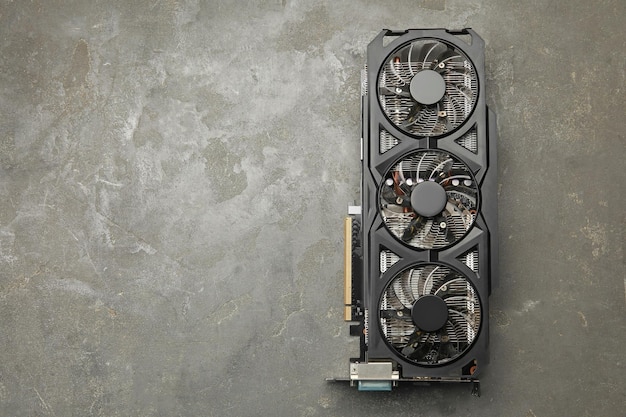
- Seasonic: Seasonic produces very high-quality PSUs.
- Corsair: Corsair is a great alternative to Seasonic, high reliability.
- Be Quiet!: Be Quiet! is famous for making silent components, power supplies included.
In summary, selecting a silent power supply is critical for building a quiet PC. Whether opting for a fanless model or a high-efficiency PSU with a quiet fan, the right choice can significantly reduce noise levels and contribute to a more peaceful computing experience. Always prioritize quality and efficiency to ensure both silence and reliable performance.
Optimizing Storage for Silence
Traditional mechanical hard drives (HDDs) are noisy due to their spinning platters and moving heads. Replace them with solid-state drives (SSDs), which have no moving parts and operate silently. SSDs also offer faster performance.
NVMe SSDs
Consider NVMe SSDs for even faster performance. These drives plug directly into the motherboard’s M.2 slot and offer significantly higher speeds than traditional SATA SSDs.
External Storage
If you need a lot of storage and can’t afford large SSDs, consider using an external HDD. This keeps the noise away from your PC.
To summarize, the advantages of upgrading to SSD storage include the reliability and better speed performance. Other advantages include:
- Instant loading: Faster load times for programs and files.
- Better lifespan than HDD: Greater durability, less prone to failure.
- Silent Operation: As mentioned earlier, it doesn’t create any noise.
In conclusion, optimizing storage for silence is essential in building a quiet PC. Switching to SSDs not only eliminates mechanical noise but also significantly improves system performance. By carefully selecting SSDs that meet your storage needs and budget, you can achieve a computing experience that is both silent and efficient.
Cable Management and Airflow
Proper cable management improves airflow, which helps keep components cool and reduces the need for fans to spin at high speeds. Route cables behind the motherboard tray and use zip ties to keep them organized.
Airflow
Ensure good airflow by using the appropriate number of case fans. Typically, having one or two intake fans at the front and one exhaust fan at the rear is sufficient.
Dust Filters
Use dust filters on intake fans to prevent dust buildup, which can impede airflow and cause fans to work harder and louder.
Great cable management makes all the difference, you need to keep things cool and tidy. The steps include:
- Cable Ties: Bundle cables to keep the clear, keep them tied together.
- Airflow in mind: Optimize for cool intake.
- Cleaning: Always keep the PC clean and free of dust.
In summary, effective cable management plays a key role in maintaining a quiet and efficient PC. By organizing cables to improve airflow and reduce dust accumulation, you can ensure that your components stay cool and operate quietly. This not only enhances the overall performance of your system but also contributes to a more pleasant and peaceful computing experience.
Budgeting and Component Selection for 2025
Building a silent PC for under $1000 in 2025 requires careful budgeting and component selection. Prices may fluctuate, so it’s essential to keep an eye on deals and promotions.
Example Build
Here’s an example build you can try.
CPU
AMD Ryzen 5 5600X – $150
Consider getting another more recent, more expensive CPU. The Ryzen 5 5600X should be enough:
- Good value: A great baseline option for an entry model.
- Excellent Gaming: Should handle all games thrown at it.
In conclusion, while costs may change, proper planning and research will enable you to construct a silent PC for under $1000 in 2025. Keep an eye on prices, seize offers, and carefully choose parts that fit your needs within a budget to achieve a noise-free computing experience.
| Key Point | Brief Description |
|---|---|
| ✅ CPU Cooler | Opt for fanless or high-quality air coolers. |
| 🔈 Quiet Case | Sound dampening and case design greatly minimize noise. |
| 💾 Silent Storage | Use SSDs to eliminate mechanical noise and boost speed. |
| 💨 Cable Management | Improves airflow, reduces fan noise and dust. |
FAQ
▼
Not necessarily. By choosing efficient components and optimizing cooling, you can maintain high performance levels while minimizing noise.
▼
Water cooling can be quieter if done correctly. However, it is more expensive and requires more maintenance than air cooling.
▼
The case is very important. Look for cases with sound dampening materials, thick panels, and good airflow to minimize noise.
▼
Yes, you can. Replace noisy components like fans and HDDs, improve cable management, and add sound dampening materials to the case.
▼
If silence is a top priority, then yes. Fanless PSUs eliminate fan noise entirely, providing a completely silent power solution.
Conclusion
Building a silent PC for under $1000 in 2025 is a realistic and rewarding endeavor. By carefully selecting components, optimizing airflow, and managing your budget, you can create a computing experience that is both powerful and peaceful.
